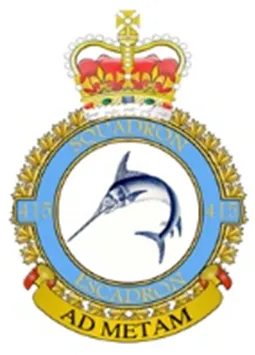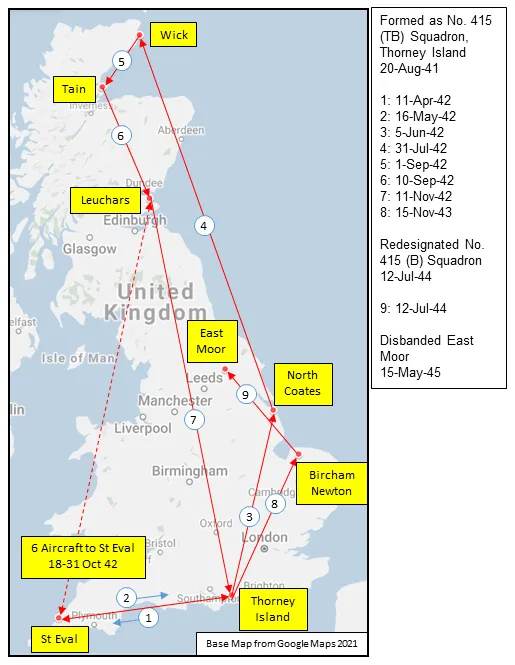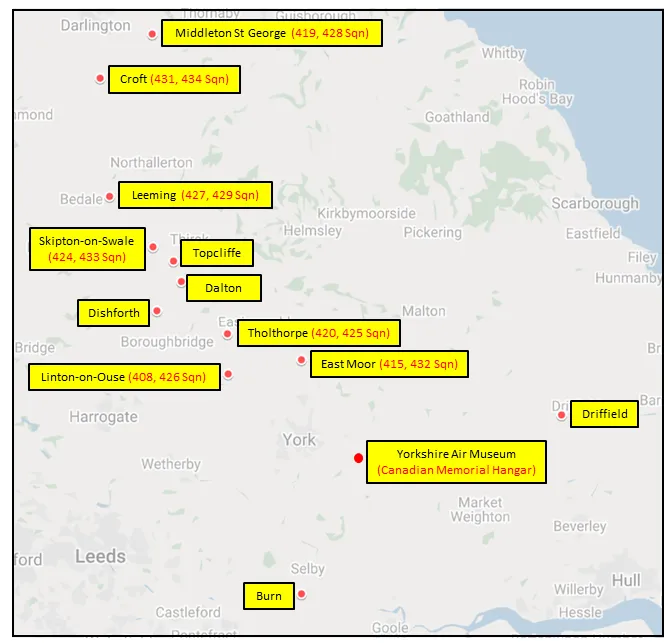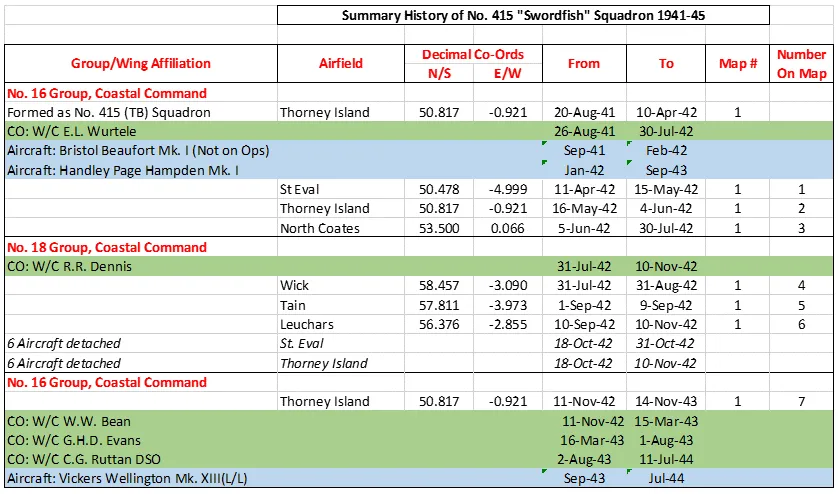1942-March-13
Killed in Action
Hampden Mk. I AT247
Vancouver, British Columbia
1942-March-13
Killed in Action
Hampden Mk. I AT247
Toronto, Ontario
1942-March-13
Killed in Action
Hampden Mk. I AT247
Regina, Saskatchewan (parents)
1942-March-13
Killed in Action
Hampden Mk. I AT247
Fredericton, New Brunswick
1942-March-23
Killed in Action
Hampden Mk. I AT230
Orlando, Florida, USA
1942-March-23
Killed in Action
Hampden Mk. I AT230
Brantford, Ontario
1942-March-23
Killed in Action
Hampden Mk. I AT230
Montreal, Quebec
1942-March-23
Killed in Action
Hampden Mk. I AT230
Denver, Colorado, USA
1942-May-29
Killed in Action
Hampden Mk. I AT236
Corwin, North Wales
1942-May-29
Killed in Action
Hampden Mk. I AT236
Westmount, Quebec
1942-May-29
Killed in Action
Hampden Mk. I AT236
Cornwall, Ontario
1942-May-29
Killed in Action
Hampden Mk. I AT236
Cornwall, Ontario
1942-June-04
Killed in Action
Hampden Mk. I AT240
Qu'Appelle, Saskatchewan
1942-June-04
Killed in Action
Hampden Mk. I AT240
Glasgow, Scotland
1942-June-04
Killed in Action
Hampden Mk. I AT240
Lethbridge, Alberta
1942-June-08
Killed in Action
Hampden Mk. I AT237
Timmins, Ontario
1942-June-24
Killed in Action
Hampden Mk. I AT242
Princeton, Ontario
1942-June-24
Killed in Action
Hampden Mk. I AT242
Blackie, Alberta
1942-June-24
Killed in Action
Hampden Mk. I AT242
Beverley, Alberta
1942-June-24
Killed in Action
Hampden Mk. I AT242
Outremont, Quebec (parents)
1942-June-27
Killed in Action
Hampden Mk.I P1153
Athens, Ontario
1942-June-27
Killed in Action
Hampden Mk.I P1153
Saskatoon, Saskatchewan
1942-June-27
Killed in Action
Hampden Mk.I P1153
Montreal, Quebec
1942-June-27
Killed in Action
Hampden Mk.I P1153
Toronto, Ontario
1942-June-28
Killed in Action
Hampden Mk. I AT245
Sussex Corner, King's County, New Brunswick
1942-June-28
Killed in Action
Hampden Mk. I AT245
Parkman, Saskatchewan
1942-June-28
Killed in Action
Hampden Mk. I AT245
Edmonton, Alberta (parents)
1942-June-28
Killed in Action
Hampden Mk. I AT245
Berwick, Kings County, Nova Scotia (parents)
1942-July-02
Killed in Action
Hampden Mk. I AT235
Regina, Saskatchewan
1942-July-02
Killed in Action
Hampden Mk. I AT235
London, England
1942-July-02
Killed in Action
Hampden Mk. I AT235
Saltcoats, Saskatchewan
1942-July-02
Killed in Action
Hampden Mk. I AT235
Reston, Manitoba
1942-July-31
Killed in Action
Hampden I AD762
Vancouver, British Columbia
1942-July-31
Killed in Action
Hampden I AD762
Toronto, Ontario
1942-July-31
Killed in Action
Hampden I AD762
Medicine Hat, Alberta
1942-July-31
Killed in Action
Hampden I AD762
Edmonton, Alberta
1942-October-04
Killed in Action
Hampden TB1 AE360
Newfoundland
1942-October-04
Killed in Action
Hampden TB1 AE360
St John's, Newfoundland
1942-November-01
Killed in Action
Hampden Mk. I / T.B.I AT193
Riverside, Ontario
1942-November-07
Prisoner of War
Hampden Mk. I / T.B.I AT241
Westmount, Quebec
1942-November-08
Prisoner of War
Hampden Mk. I / T.B.I AT241
Winnipeg, Manitoba
1943-February-18
Killed in Action
Hampden I AE435
Lachine, Quebec
1943-February-18
Killed in Action
Hampden I AE435
Ottawa, Ontario
1943-February-18
Killed in Action
Hampden I AE435
Longueuil, Quebec
1943-February-18
Killed in Flying Accident
Hampden I AE435
Arthurette, New Brunswick (Parents)
1943-March-11
Killed in Action
Hampden Mk. I / T.B.I AT114
Montreal, Quebec
1943-March-11
Killed in Action
Hampden Mk. I / T.B.I AT114
Toronto, Ontario
1943-March-11
Killed in Action
Hampden Mk. I / T.B.I AT114
Brownsville, Ontario
1943-March-19
Killed in Action
Hampden I AE418
Saskatoon, Saskatchewan
1943-March-19
Killed in Action
Hampden I AE418
Marquis, Saskatchewan
1943-March-19
Killed in Action
Hampden I AE418
Stoney Plain, Alberta
1943-March-24
Prisoner of War
Hampden I AE395
Vancouver, British Columbia
1943-March-24
Prisoner of War
Hampden I AE395
Moncton, New Brunswick
1943-March-24
Prisoner of War
Hampden I AE395
Vancouver, British Columbia
1943-March-24
Killed in Action
Hampden I AE395
Calgary, Alberta
1943-April-03
Killed in Action
Hampden L4084
Nordegg, Alberta
1943-April-03
Killed in Action
Hampden L4084
Windsor, Ontario
1943-April-03
Killed in Action
Hampden L4084
Cultus Lake, British Columbia
1943-April-03
Killed in Action
Hampden L4084
Saskatoon, Saskatchewan
1943-April-10
Killed in Action
Hampden Mk. l P1151
Ottawa, Ontario
1943-April-10
Killed in Action
Hampden Mk. l P1151
Glenboro, Manitoba (parents)
1943-April-24
Killed in Action
Hampden Mk. I / T.B.I AT244
Barrhead, Alberta
1943-May-18
Killed in Action
Hampden Mk. I AN153
Fredericton, New Brunswick
1943-May-18
Killed in Action
Hampden Mk. I AN153
Hamilton, Ontario
1943-May-18
Killed in Action
Hampden Mk. I AN143
Windsor, Ontario
1943-June-11
Killed in Action
Hampden Mk. I / T.B.I AT243
Glendon, Alberta
1943-June-11
Killed in Action
Hampden Mk. I / T.B.I AT243
Mount Hope, Prince Edward Island (parents)
1943-June-14
Killed in Action
Hampden Mk.I X2961
Hanley, Saskatchewan
1943-June-14
Killed in Action
Hampden Mk.I X2961
Sarnia, Ontario
1943-June-14
Killed in Action
Hampden Mk.I X2961
Grande Prairie, Alberta (parents)
1943-June-14
Killed in Action
Hampden Mk.I X2961
St James, Manitoba
1943-July-17
Prisoner of War
Hampden TB X3145
Tecumseh, Ontario.
1943-July-17
Killed in Action
Hampden TB X3145
Windsor, Ontario
1943-July-17
Killed in Action
Hampden TB X3145
Nut Mountain, Saskatchewan
1943-July-26
Killed in Action
Hampden Mk. I P5301
Port Dover, Ontario
1943-July-26
Killed in Action
Hampden Mk. I P5301
St John, New Brunswick
1943-August-20
Prisoner of War
Hampden Mk.I X2898
Biggar, Saskatchewan
1943-August-20
Prisoner of War
Hampden Mk.I X2898
Calgary, Alberta
1943-September-06
Killed in Action
Hampden Mk. l L4076
St Louis, Missouri, USA
1943-September-06
Killed in Action
Hampden Mk. l L4076
Noel Shore, Hants County, Nova Scotia
1943-September-06
Killed in Action
Hampden Mk. l L4076
Dinsmore, Saskatchewan
1943-September-09
Killed in Action
Hampden I AD799
Clarkson, Ontario
1943-September-09
Killed in Action
Hampden I AD799
Montreal, Quebec
1943-September-09
Killed in Action
Hampden I AD799
Vancouver, British Columbia
1944-January-20
Killed in Action
Albacore Mk. I X9280
Ottawa, Ontario
1944-February-07
Killed in Action
Wellington B. Mk. X HZ655
Pembroke, Ontario
1944-February-07
Killed in Action
Wellington B. Mk. X HZ655
Toronto, Ontario (parents)
1944-February-07
Killed in Action
Wellington B. Mk. X HZ655
Toronto, Ontario (parents)
1944-February-07
Killed in Action
Wellington B. Mk. X HZ655
Vancouver, British Columbia
1944-February-07
Killed in Action
Wellington B. Mk. X HZ655
Castor, Alberta (parents)
1944-February-07
Killed in Action
Wellington B. Mk. X HZ655
London, Ontario (parents)
1944-February-07
Killed in Action
Wellington B. Mk. X HZ655
Westmount, Quebec
1944-February-08
Killed in Action
Wellington B. Mk. XIII HZ642
Montreal, Quebec
1944-February-08
Killed in Action
Wellington B. Mk. XIII HZ642
St Louis, Missouri, USA
1944-February-08
Killed in Action
Wellington B. Mk. XIII HZ642
Silver Park, Saskatchewan
1944-February-08
Killed in Action
Wellington B. Mk. XIII HZ642
Loco, British Columbia
1944-February-08
Killed in Action
Wellington B. Mk. XIII HZ642
Pine Inn, California, USA
1944-February-08
Killed in Action
Wellington B. Mk. XIII HZ642
Toronto, Ontario
1944-March-24
Killed in Action
Albacore Mk. I X8940
Cereal, Alberta
1944-June-13
Killed in Action
Wellington B. Mk. X HZ659
Toronto, Ontario
1944-June-13
Killed in Action
Wellington B. Mk. X HZ659
Brantford, Ontario
1944-June-13
Killed in Action
Wellington B. Mk. X HZ659
South River, Ontario
1944-June-13
Killed in Action
Wellington B. Mk. X HZ659
Mill Roches, Ontario
1944-June-13
Killed in Action
Wellington B. Mk. X HZ659
Winkler, Manitoba
1944-June-13
Killed in Action
Wellington B. Mk. X HZ659
Barrie, Ontario
1944-June-13
Killed in Action
Wellington B. Mk. X HZ659
Bellevue, Alberta
1944-July-13
Killed in Action
Wellington Mk. XII (L/L) MF494
Haileybury, Ontario
1944-July-13
Killed in Action
Wellington Mk. XII (L/L) MF494
Owendale, Alberta
1944-July-13
Killed in Action
Wellington Mk. XII (L/L) MF494
Whonnock, British Columbia
1944-July-13
Killed in Action
Wellington Mk. XII (L/L) MF494
Montreal, Quebec
1944-July-13
Killed in Action
Wellington Mk. XII (L/L) MF494
Kelloe, Manitoba
1944-July-13
Killed in Action
Wellington Mk. XII (L/L) MF494
Oshawa, Ontario (parents)
1944-July-21
Killed in Action
Albacore Mk. I X9281
Smiths Falls, Ontario
1944-July-21
Killed in Action
Albacore Mk. I X9281
Timmins, Ontario
1944-July-28
Survived
Halifax B.Mk.III MZ686
1944-July-28
Survived
Halifax B.Mk.III MZ686
1944-July-28
Survived
Halifax B.Mk.III MZ686
1944-July-28
Survived
Halifax B.Mk.III MZ686
1944-July-28
Survived
Halifax B.Mk.III MZ686
1944-July-28
Survived
Halifax B.Mk.III MZ686
Toronto, Ontario
1944-July-29
Killed in Action
Halifax B/A.Mk.III LW595
Knock, Isle of Lewis, Scotland
1944-July-29
Survived
Halifax B.Mk.III MZ686
1944-July-29
Prisoner of War
Halifax B/A.Mk.III LW595
1944-July-29
Killed in Action
Halifax B/A.Mk.III LW595
Neudorf, Saskatchewan
1944-July-29
Killed in Action
Halifax B/A.Mk.III LW595
Vancouver, British Columbia
1944-July-29
Killed in Action
Halifax B/A.Mk.III LW595
Edmonton, Alberta
1944-July-29
Killed in Action
Halifax B/A.Mk.III LW595
Toronto, Ontario
1944-July-29
Killed in Action
Halifax B/A.Mk.III LW595
Regina, Saskatchewan
1944-July-29
Killed in Action
Halifax B/A.Mk.III LW595
Dalhousie, Ontario
1944-July-29
Killed in Action
Halifax B/A.Mk.III LW595
Darlingford, Manitoba
1944-August-21
Killed in Flying Accident
Halifax B.Mk.III MZ633
Readlyn, Saskatchewan
1944-August-21
Killed in Flying Accident
Halifax B.Mk.III MZ633
Readlyn, Saskatchewan
1944-August-21
Killed in Flying Accident
Halifax B.Mk.III MZ633
Winnipeg, Manitoba
1944-August-21
Killed in Flying Accident
Halifax B/A.Mk.III NA609
Calgary, Alberta
1944-August-21
Killed in Flying Accident
Halifax B/A.Mk.III NA609
Edmonton, Alberta
1944-August-21
Killed in Flying Accident
Halifax B/A.Mk.III NA609
Twin Butte, Alberta
1944-August-21
Killed in Flying Accident
Halifax B/A.Mk.III NA609
Calgary, Alberta
1944-August-21
Killed in Flying Accident
Halifax B/A.Mk.III NA609
Toronto, Ontario
1944-August-21
Killed in Flying Accident
Halifax B.Mk.III MZ633
Perth, Ontario
1944-August-21
Killed in Flying Accident
Halifax B.Mk.III MZ633
Grimsby, Ontario
1944-August-21
Killed in Flying Accident
Halifax B/A.Mk.III NA609
Sudbury, Ontario
1944-August-21
Killed in Flying Accident
Halifax B.Mk.III MZ633
Lang Bay, British Columbia (parents)
1944-October-13
Killed in Action
Halifax B.Mk.III MZ690
Winnipeg, Manitoba
1944-October-13
Killed in Action
Halifax B.Mk.III NP935
Polonia, Manitoba
1944-November-02
Killed in Action
Halifax B/A.Mk.III NA583
Belfast, Northern Ireland
1944-November-02
Prisoner of War
Halifax B.Mk.III MZ603
1944-November-02
Survived
Halifax B.Mk.III MZ882
1944-November-02
Survived
Halifax B.Mk.III MZ882
1944-November-02
Survived
Halifax B.Mk.III MZ882
1944-November-02
Survived
Halifax B.Mk.III MZ882
1944-November-02
Survived
Halifax B.Mk.III MZ882
1944-November-02
Survived
Halifax B.Mk.III MZ882
1944-November-02
Survived
Halifax B.Mk.III MZ882
1944-November-02
Prisoner of War
Halifax B.Mk.III MZ603
1944-November-02
Killed in Action
Halifax B/A.Mk.III NA583
Prince Rupert, British Columbia
1944-November-02
Killed in Action
Halifax B.Mk.III MZ603
Transcona, Manitoba
1944-November-02
Killed in Action
Halifax B/A.Mk.III NA583
Vancouver, British Columbia
1944-November-02
Killed in Action
Halifax B/A.Mk.III NA583
Wood Mountain, Saskatchewan
1944-November-02
Killed in Action
Halifax B/A.Mk.III NA583
Portage La Prairie, Manitoba
1944-November-02
Killed in Action
Halifax B.Mk.III MZ603
Toronto, Ontario
1944-November-02
Killed in Action
Halifax B/A.Mk.III NA583
Red Deer, Alberta
1944-November-02
Killed in Action
Halifax B/A.Mk.III NA583
Port Hope, Ontario
1944-November-02
Killed in Action
Halifax B.Mk.III MZ603
Montreal, Quebec
1944-November-02
Killed in Action
Halifax B.Mk.III MZ603
Lockport, Shelbourne County, Nova Scotia
1944-November-02
Killed in Action
Halifax B.Mk.III MZ603
Victoria, British Columbia
1944-November-02
Killed in Action
Halifax B/A.Mk.III NA583
Picton, Ontario
1944-November-02
Killed in Action
Halifax B.Mk.III MZ603
Toronto, Ontario
1945-January-05
Prisoner of War Early Release
Halifax B.Mk.III MZ476
Westmount, Quebec
1945-January-06
Killed in Action
Halifax B.Mk.III MZ456
1945-January-06
Killed in Action
Halifax B.Mk.III MZ456
Wetaskiwin, Alberta
1945-January-06
Killed in Action
Halifax B.Mk.III MZ456
Lambeth, Ontario
1945-January-06
Killed in Action
Halifax B.Mk.III MZ456
Windsor, Ontario
1945-January-06
Killed in Action
Halifax B.Mk.III MZ456
Blandworth, Saskatchewan
1945-January-06
Killed in Action
Halifax B.Mk.III MZ456
Vancouver, British Columbia
1945-January-06
Killed in Action
Halifax B.Mk.III MZ456
Bow Island, Alberta
1945-January-16
Prisoner of War
Halifax B.Mk.III NR253
1945-January-16
Prisoner of War
Halifax B.Mk.III NR253
1945-January-16
Prisoner of War
Halifax B.Mk.III NR253
1945-January-16
Prisoner of War
Halifax B.Mk.III NR253
1945-January-16
Prisoner of War
Halifax B.Mk.III NR253
St Claude, Minnesota USA
1945-January-16
Killed in Action
Halifax B.Mk.III NR253
Trout Creek, Ontario
1945-January-16
Killed in Action
Halifax B.Mk.III NR253
Los Angeles, California, USA
1945-February-09
Evader
Halifax B.Mk.III NR249
1945-February-09
Prisoner of War
Halifax B.Mk.III NR249
1945-February-09
Prisoner of War
Halifax B.Mk.III NR249
Dartmouth, Nova Scotia
1945-February-09
Prisoner of War
Halifax B.Mk.III NR249
1945-February-09
Prisoner of War
Halifax B.Mk.III NR249
Windsor, Ontario
1945-February-09
Prisoner of War
Halifax B.Mk.III NR249
Quebec
1945-February-09
Killed in Action
Halifax B.Mk.III NR249
Lansdowne, Ontario
1945-February-24
Killed in Action
Halifax B.Mk.III NP936
Brussels, Ontario
1945-February-24
Killed in Action
Halifax B.Mk.III NP936
Kitchener, Ontario
1945-February-24
Killed in Action
Halifax B.Mk.III NP936
Toronto, Ontario
1945-February-24
Killed in Action
Halifax B.Mk.III NP936
Swift Current, Saskatchewan
1945-February-24
Killed in Action
Halifax B.Mk.III NP936
Ludlow, Massachusetts, USA (parents)
1945-February-24
Killed in Action
Halifax B.Mk.III NP936
Regina, Saskatchewan
1945-March-05
Prisoner of War
Halifax B/A/Met.Mk.III NA204
1945-March-06
Prisoner of War
Halifax B/A/Met.Mk.III NA204
1945-March-06
Prisoner of War
Halifax B/A/Met.Mk.III NA204
1945-March-06
Prisoner of War
Halifax B/A/Met.Mk.III NA204
1945-March-06
Prisoner of War
Halifax B/A/Met.Mk.III NA204
1945-March-06
Prisoner of War
Halifax B/A/Met.Mk.III NA204
1945-March-06
Prisoner of War
Halifax B/A/Met.Mk.III NA204
1945-March-06
Prisoner of War
Halifax B/A/Met.Mk.III NA204
1945-March-09
Prisoner of War
Halifax B/A/Met.Mk.III NA186
1945-March-09
Prisoner of War
Halifax B/A/Met.Mk.III NA186
1945-March-09
Prisoner of War
Halifax B/A/Met.Mk.III NA186
1945-March-09
Prisoner of War
Halifax B/A/Met.Mk.III NA186
1945-March-09
Prisoner of War
Halifax B/A/Met.Mk.III NA186
1945-March-09
Prisoner of War
Halifax B/A/Met.Mk.III NA186
1945-March-09
Prisoner of War
Halifax B/A/Met.Mk.III NA186
1945-March-25
Prisoner of War
Halifax B.Mk.III MZ907
1945-March-25
Prisoner of War
Halifax B.Mk.III MZ907
1945-March-25
Prisoner of War
Halifax B.Mk.III MZ907
1945-March-25
Prisoner of War KIA
Halifax B.Mk.III MZ907
Moose Jaw, Saskatchewan
1945-March-25
Killed in Action
Halifax B.Mk.III MZ907
Toronto, Ontario
1945-March-25
Killed in Action
Halifax B.Mk.III MZ907
Toronto, Ontario
1945-March-25
Killed in Action
Halifax B.Mk.III MZ907
Hamilton, Ontario
1945-March-31
Killed in Action
Halifax B.Mk.III MZ922
Kildonan, Manitoba
1945-March-31
Killed in Action
Halifax B.Mk.III MZ922
Windsor, Ontario
1945-March-31
Killed in Action
Halifax B.Mk.III MZ922
Lake Alma, Saskatchewan
1945-March-31
Killed in Action
Halifax B.Mk.III MZ922
Victoria, British Columbia
1945-March-31
Killed in Action
Halifax B.Mk.III MZ922
Toronto, Ontario
1945-March-31
Killed in Action
Halifax B.Mk.III MZ922
Winnipeg, Manitoba
1945-March-31
Killed in Action
Halifax B.Mk.III MZ922
Toronto, Ontario
1945-April-10
Killed in Action
Halifax B/A/Met.Mk.III NA185
Waterloo, Ontario
1945-April-10
Killed in Action
Halifax B/A/Met.Mk.III NA185
Windsor, Ontario
1945-April-10
Killed in Action
Halifax B/A/Met.Mk.III NA185
Kitchener, Ontario
1945-April-10
Killed in Action
Halifax B/A/Met.Mk.III NA185
Kitchener, Ontario
1945-April-10
Killed in Action
Halifax B/A/Met.Mk.III NA185
London, Ontario
1945-April-10
Killed in Action
Halifax B/A/Met.Mk.III NA185
Windsor, Ontario
1977-March-31
Killed in Flying Accident
Argus 2 20737
1977-March-31
Killed in Flying Accident
Argus 2 20737
Calgary, Alberta
1977-March-31
Killed in Flying Accident
Argus 2 20737
Kinkora, Prince Edward Island

![]() on August 20, 1941. It was a originally a torpedo bomber squadron, briefly flying Bristol Beaufort Mk 1 (but not operationally) before transferring to Handley Page Hampden aircraft, with the squadron letters GX. The squadron flew from a number of bases as part of Coastal Command Nos 16 and 19 Groups. Over the course of 1942, these bases ranged from the south of England (St. Eval, Cornwall) to the north of Scotland (Wick, Caithness). In November 1942, it settled at Thorney Island for a year before moving to Bircham Newton, Norfolk, in November 1943. From September and October 1943, the squadron flew Wellington Mk. XIII and Fairey Albacore Mk. I, the latter having the squadron code of NH. The squadron was active on D-Day, laying smoke screens for the Allied shipping. After D-Day, there was less need for maritime operations, and the squadron was designated 415(B), was equipped with Handley-Page Halifax III and VII aircraft, and joined 6 Group (RCAF) of Bomber Command, flying from East Moor, Yorkshire
on August 20, 1941. It was a originally a torpedo bomber squadron, briefly flying Bristol Beaufort Mk 1 (but not operationally) before transferring to Handley Page Hampden aircraft, with the squadron letters GX. The squadron flew from a number of bases as part of Coastal Command Nos 16 and 19 Groups. Over the course of 1942, these bases ranged from the south of England (St. Eval, Cornwall) to the north of Scotland (Wick, Caithness). In November 1942, it settled at Thorney Island for a year before moving to Bircham Newton, Norfolk, in November 1943. From September and October 1943, the squadron flew Wellington Mk. XIII and Fairey Albacore Mk. I, the latter having the squadron code of NH. The squadron was active on D-Day, laying smoke screens for the Allied shipping. After D-Day, there was less need for maritime operations, and the squadron was designated 415(B), was equipped with Handley-Page Halifax III and VII aircraft, and joined 6 Group (RCAF) of Bomber Command, flying from East Moor, Yorkshire ![]() (RCAF No 62 Base),where it remained until the end of hostilities. Its squadron code was changed to 6U [this is according to Moyes and Wikipedia, but Kostenuk gives "GU", which may be a misprint]. Its last mission was on April 25, 1945. The squadron was disbanded at East Moor on May 15, 1945.
(RCAF No 62 Base),where it remained until the end of hostilities. Its squadron code was changed to 6U [this is according to Moyes and Wikipedia, but Kostenuk gives "GU", which may be a misprint]. Its last mission was on April 25, 1945. The squadron was disbanded at East Moor on May 15, 1945.



![]() , and equipped with the Canadair CP-107 Argus. The Squadron was quick to establish a Canadian endurance record on 26 July 1961, flying 30 hours and 20 minutes, non-stop. During its two decades at Summerside, the Swordfish squadron conducted a variety of missions including anti-submarine, fisheries and pollution, and Northern sovereignty patrols, operating from an ever-increasing number of deployment locations. In 1964, the Squadron assumed the Search and Rescue duties for the Maritime Air Command. In 1981, all the Maritime Patrol Squadrons converted to the Lockheed CP-140 Aurora aircraft and all the East Coast CP-140 squadrons were consolidated at Canadian Forces Base (CFB) Greenwood
, and equipped with the Canadair CP-107 Argus. The Squadron was quick to establish a Canadian endurance record on 26 July 1961, flying 30 hours and 20 minutes, non-stop. During its two decades at Summerside, the Swordfish squadron conducted a variety of missions including anti-submarine, fisheries and pollution, and Northern sovereignty patrols, operating from an ever-increasing number of deployment locations. In 1964, the Squadron assumed the Search and Rescue duties for the Maritime Air Command. In 1981, all the Maritime Patrol Squadrons converted to the Lockheed CP-140 Aurora aircraft and all the East Coast CP-140 squadrons were consolidated at Canadian Forces Base (CFB) Greenwood ![]() . On the afternoon of 24 July 1981, Argus 736, call sign "Sidney 02", conducted a fly-past for a ceremonial parade to celebrate 415 Squadron’s welcome to Greenwood; its Change of Command ceremony, and, the last official Canadian Forces flight of the Argus. In 1982, the Squadron received its Standard in recognition of 25 years of dedicated service to the Crown and the people of Canada.
. On the afternoon of 24 July 1981, Argus 736, call sign "Sidney 02", conducted a fly-past for a ceremonial parade to celebrate 415 Squadron’s welcome to Greenwood; its Change of Command ceremony, and, the last official Canadian Forces flight of the Argus. In 1982, the Squadron received its Standard in recognition of 25 years of dedicated service to the Crown and the people of Canada. ![]() where they flew surveillance patrols in the Adriatic in support of the United Nation’s arms embargo of the Former Republic of Yugoslavia. The Squadron later participated in Operation ASSISTANCE, providing humanitarian assistance to the people of Manitoba during the great flood of 1997. Throughout the 80s and 90s, anti-submarine warfare training and anti-submarine patrols remained the focal point for 415 Squadron. With the end of the Cold War and new asymmetric threats emerging, the Aurora fleet became more involved in overland missions; to align the CP140 fleet with this new reality, all the CP140 squadrons were rebranded as Long Range Patrol (LRP) Squadrons. 415, along with the other LRP Squadrons, were active participants in Operation APOLLO, deploying crews to the Arabian Sea region in support of the American-led Campaign Against Terrorism (CAT) following the events of September 11, 2001. The first two crews rotated through on deployments of six months duration. For the remainder of the operation, crews were rotated every 56 days. The CP-140 commitment to Operation APOLLO ended in July 2003.
where they flew surveillance patrols in the Adriatic in support of the United Nation’s arms embargo of the Former Republic of Yugoslavia. The Squadron later participated in Operation ASSISTANCE, providing humanitarian assistance to the people of Manitoba during the great flood of 1997. Throughout the 80s and 90s, anti-submarine warfare training and anti-submarine patrols remained the focal point for 415 Squadron. With the end of the Cold War and new asymmetric threats emerging, the Aurora fleet became more involved in overland missions; to align the CP140 fleet with this new reality, all the CP140 squadrons were rebranded as Long Range Patrol (LRP) Squadrons. 415, along with the other LRP Squadrons, were active participants in Operation APOLLO, deploying crews to the Arabian Sea region in support of the American-led Campaign Against Terrorism (CAT) following the events of September 11, 2001. The first two crews rotated through on deployments of six months duration. For the remainder of the operation, crews were rotated every 56 days. The CP-140 commitment to Operation APOLLO ended in July 2003.



